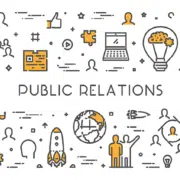Don’t Be Spooked by Adding PR To Your Budget
Are you in budget mode? Getting ready to determine how you are going to allocate your 2019 marketing dollars? Don’t let the dollar signs scare you away from planning a spooktacular year ahead filled with spellbinding marketing campaigns and magical media coverage. When planning your communications budget there is one important item to consider: don’t confuse your marketing budget with your public relations (PR) budget. Your marketing dollars are spent on content you control, and ultimately, controlling how you promote your brand to the public. PR on the other hand, is when your content is presented by someone outside of your brand’s control, making it more credible and authentic to the public and building a reputation.
Let’s get back to the basics. Marketing must be in your company’s budget. You need to share your brand and reach your target audience and that’s done through various formats, such as advertisements, your website, marketing collateral, newsletters and more. And these all cost money, and therefore, a budget is needed.
PR is earning a third-party endorsement, which, for example, is when a journalist or social media influencer writes or talks favorably about you and your organization. This translates into positive publicity and when it works, it can have more value than any other format. As a result, it also must be in your company’s budget.
The PR world has evolved over the past decade to be more beneficial in helping businesses meet their goals. Why you may ask? Today we blend old school PR with new school PR, giving us more bang for the buck. Traditional PR includes the development of press releases to share company news or to accompany a pitch, hosting press conferences to unveil even bigger news, pitching story ideas to gain further exposure in regional, national and industry media, and more.
Modern PR takes “getting the word out” to a whole new level. The internet has made the world much smaller and easier for companies to become more global in size. No matter the size of a business, however, growing a company is about building reputation. Today, a solid reputation is built on good storytelling that is consistently reaching your target audience via bloggers, influencers, social media, journalists, other media and more. Do a quick Google search of your company. What are the top results? If it’s not reinforcing your brand or telling a good story that is speaking to your ideal customer, then it’s time to invest in your company’s PR strategy.
When traditional and modern PR work in tandem, it will result in publicity that has a more powerful impact on your brand, and your business goals. As a result, it is important to establish a PR budget for your company. Things to consider in building a budget include:
- Staff time
- Development of a year-round PR plan (be proactive, not reactive)
- Media training for employees (they’ll need to know how to speak in front of camera)
- Media contact database development (and ensure it’s maintained as contacts come and go)
- Content development (build a library of jam-packed storytelling material that can be used to pitch to the media and influencers)
- Press conferences (printing costs, sound and podium, branding/signage, decorations, scripting, etc.)
- Press release distribution (extend your reach by using a third-party distribution network, such as PRNewswire or PRWeb)
- Travel expenses (set up in-person meet and greets with key influencers/journalists)
- Crisis communications (keep your reputation on par by having a PR plan in place)
- Subscriptions to the magazines and newspapers where you pitch (often times online and printed versions differ)
- Support from an agency if you need help (contact Chartwell Agency to plan and/or implement your PR strategy)
Communications budgets differ for each organization, but there in one thing every business must keep in mind: don’t creep into your marketing budget to pay for your PR expenses. A dedicated PR budget will help to further build your reputation and create more business.









